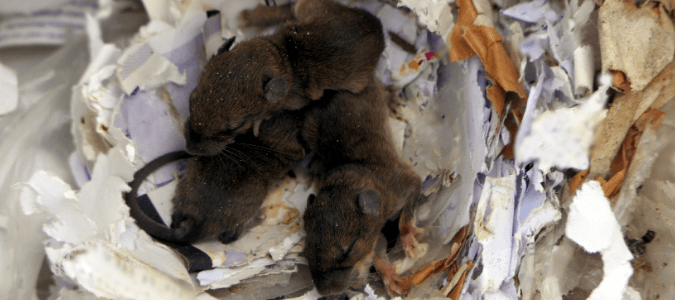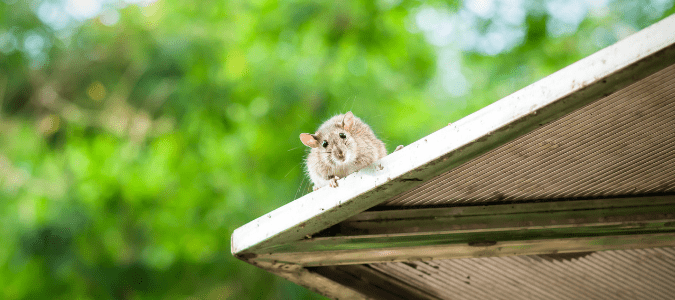
Spotting a rat’s nest might be the first sign of an infestation in your home. But how do you know if what you’re seeing is the home of one of these hard-to-spot rodents, particularly if you don’t observe the rat itself? Rodents tend to nest in more protected areas that homeowners don’t usually frequent. In addition, different species of rats build nests that typically vary in appearance and can be found in different spots on your property. Generally speaking, a rat’s nest looks like a ball that is 4 to 6 inches in diameter that is loosely woven.
Norway rats, also called sewer rats or brown rats, are stocky rodents that often dig burrows in moist areas, such as under woodpiles or trash, along home foundations, fields or in gardens. They line these nests with fibrous materials, such as cloth or shredded paper. If these rats come into a building, they often stay on the ground floor or nest in crawl spaces.
On the other hand, roof rats, sometimes referred to as black rats, are smaller rodents with longer tails that live and build their nests in areas high off the ground. In natural habitats, this typically means in and around trees, ivy, shrubs or other kinds of vegetation. In homes, roof rats often build nests in areas like attics, cabinets, walls, false ceilings and other elevated or enclosed places. They use a variety of materials for their nests, including natural materials like grass, twigs and other plant remains, as well as items found around the house, such as fabric, paper and insulation.
Since they are nocturnal creatures, rats are most active about a half-hour after sunset to a half-hour before the sun rises. Rats tend to look for food about 100 to 300 feet from the nest. A rat will eat virtually anything—seeds, fruit, soap, candy, leather, fur, nuts and even other rodents—and can eat a third of its body weight daily. The average rat has 6 litters of babies a year with between 4 to 8 pups per litter. Females can nest together, and both rats and mice establish colonies and territories.
Beyond nests, other things that you might notice when dealing with a rat infestation, include:
- rat droppings, which are usually about a half-inch long with pointed ends;
- gnaw marks on belongings or shredded materials;
- burrows or evidence of digging under your shed, garbage can, outdoor pet shelter or compost pile;
- unexplained noises in your attic or scratching noises in the wall;
- dead rats in your pool or carcasses delivered by your pet;
- bites out of nuts or fruit in your garden or yard;
- a musky odor from the rodent or the smell of urine, particularly in areas with little ventilation;
- greasy smudge marks on your wall, rafters, beams or pipes or
- live rats.
These kinds of infestations in a home can lead to a range of negative consequences. For one, rats are often destructive and might tear up parts of your house when building their nest or looking for food. Furthermore, rats have ever-growing teeth, and they have even been known to cause house fires by chewing through electrical wiring. Rats are even known to make nests in cars, trucks or other vehicles, particularly if these cars are not in frequent use.
Additionally, rats often carry diseases like Salmonella, rat bite fever, leptospirosis and murine typhus, which they can transmit to humans. Rats also often contaminate animal feed, and their diseases can be dangerous for livestock and pets.
If you suspect that you might have a rat infestation, or if you notice any of the signs we already mentioned, it’s best to reach out to a pest control specialist who can help protect your family and your home from these bothersome and destructive creatures. Wildlife and pest control pros have proven methods and can help you create a thorough pest management plan for your home. A professional can simplify your life by taking care of everything for you, so you don’t have to spend hours of precious family time trying to research a plan of attack to control these pests.
When learning more about rat infestations and what led to the problem, many homeowners have quite a few questions. For example, when people learn that rats can live in attics, they often wonder how rats get up there in the first place. Can rats get up in a tree and use a limb to gain entry into our homes?

Can Rats Climb Trees?
Unfortunately, rats are excellent climbers. In fact, one of the most common ways that rats get into homes is by climbing tree branches, utility lines, ivy or other hedges on your house or fence and making their way into our attics or crawl spaces from the roof.
This is why it’s critical to remove climbing hedges and keep your trees trimmed so that branches aren’t close to your roof. It’s also important to seal up any potential entry points along your roofline using solid materials like steel wool, since rats can chew through wood and other less durable materials like plastic sheeting and caulking.
Other ways that rats may gain access to your home are through openings that are larger than a half an inch. This might include places around your house like chimney openings, holes in the crawl space, damaged siding, broken vents, in between Spanish roof tiles, pet doors and holes around drainpipes, cables or wiring.
It’s also important to keep in mind that while roof rats particularly love oranges and other citrus trees, rats are generally omnivores, meaning that they might eat whatever food is readily available. Roof rats typically search for food in small groups and often follow routines, meaning that they usually travel along the same paths each time they go to a food source. If you’re able to identify their typical travel path, it can make it easier to know where to place traps and improve your chance of successfully removing these rodents. However, it’s also important to keep in mind that rats are suspicious creatures that might avoid a new item in their path.
This avoidance of strange objects and rats’ other behavior habits can make it difficult for homeowners without in-depth knowledge of pest control techniques to trap rats. As we mentioned previously, these rodents also multiply frequently–each female rat can give birth to over forty babies each year. This can mean that if you don’t control a rat infestation, it can quickly turn into an exponentially larger problem.
However, figuring out what type of rats you have and determining the best way to get rid of them is often time-consuming and stressful for homeowners, especially when you’re trying to deal with more important things like your job and family. Thankfully, you don’t have to deal with this all on your own. A licensed pest control professional can take care of everything for you–from inspecting your home for an infestation to helping you get rid of the pests currently in your home to helping prevent the chance of a future infestation. These professionals also know the most effective baits to put in a mouse trap and what foods are most enticing for a rat, which can make the rodent control process much more efficient.
When you contact a wildlife control specialist to handle rodent control on your property, you can have a plan of action that is tailored to your specific needs. Rodent specialists can also take care of all of the potentially dangerous aspects of rodent removal, so you don’t have to expose yourself or your family to the health risks posed by these pests.
For the most effective rodent control plan, there are steps you can take in tandem with what a professional will do to make the problem more manageable.

How To Get Rid of Roof Rats
A primary way to get rid of roof rats and reduce the chance of future infestations is to make your property less attractive to rats. Some steps you can take to deter rodents include:
- use a wire screen or steel wool to seal up any holes around your foundation or openings for vents, wires, pipes or drains;
- only use trash cans made of solid materials like metal and that have a tight-fitting lid;
- feed your pets inside if possible, only give them as much food as they regularly eat and promptly clean up any food they don’t eat instead of leaving it in their bowl;
- wait until trash day to put any kinds of smelly garbage like chicken scraps in your garbage can and wait to put the can on the curb;
- secure any potential entry points around your house, such as loose or rotting boards, damaged vents, loose doors or windows, uncapped chimneys or broken shingles;
- avoid putting food scraps (perhaps at least temporarily) in your outdoor compost bin;
- improve drainage in areas of your property where water gathers;
- frequently pick up pet waste in your yard, as rats may eat dog poop;
- prune shrubs and ground cover plants;
- weatherproof your windows and doors;
- clear any excess items in or around your house that rats could use for shelter, such as tall weeds, garden debris, log piles, boxes, crates, other household goods or dense vegetation close to your house;
- hang bird feeders on a pole or wire and use a feeder that recaptures any seeds that drop;
- promptly harvest fruit from your garden and clean up any nuts or fruit that falls on the ground;
- lock your pet door when you go to bed and
- cut tree branches that are close to your roof or the sides of your home.
While homeowners can implement many of these measures on their own, these steps should be taken to supplement a broader pest control strategy. The most efficient and effective way to rid your home of rats and to reduce the risk of future infestations is to hire a pest control professional.
Trying to handle rodent control without proper expertise or tools is often too big of a task for homeowners. Pest and wildlife control specialists have the knowledge and tools that it takes to properly handle rodent control. They can work to understand the needs and concerns of your family and help you build a pest control strategy that works best for your home.
ABC Can Help You Take Your Home Back From Rats
Although a rodent infestation can be overwhelming, you don’t have to deal with the problem on your own. The licensed technicians from ABC Home & Commercial Services have a thorough understanding of rodent behavior and habits, and can create an effective pest treatment plan for your home. For further peace of mind, we offer ongoing management programs so you don’t have to worry about any more uninvited guests.
